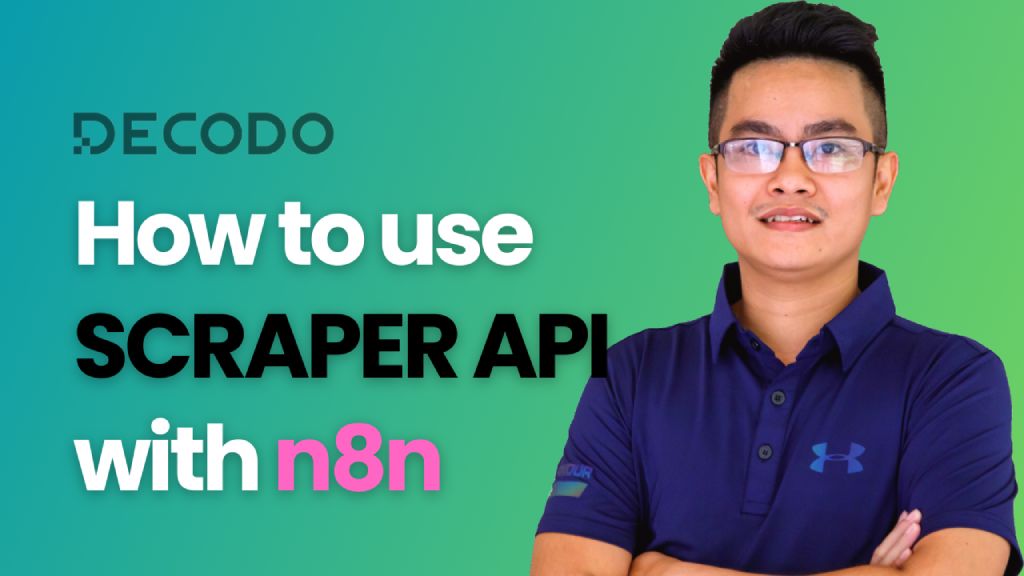Back to Templates
Decodo Scraper API Workflow Template (n8n Automation Amazon Book Purchase Report)
Watch the demo video below:
This workflow demos how to use Decodo Scraper API to crawl any public web page (headless JS, device emulation: mobile/desktop/tablet), extract structured product data from the returned HTML, generate a purchase-ready report, and automatically deliver it as a Google Doc + PDF to Slack/Drive.
Who’s it for
- Creators / Analysts who need quick product lists (books, gadgets, etc.) with prices/ratings.
- Ops & Marketing teams building weekly “top picks” reports.
- Engineers validating the Decodo Scraper API + LLM extraction pattern before scaling.
How it works / What it does
- Trigger – Manually run the workflow.
- Edit Fields (manual) – Provide inputs:
targetUrl(e.g., an Amazon category/search/listing page)deviceType(desktop|mobile|tablet)- Optional:
maxItems,notes,reportTitle,reportOwner
- Scraper API Request (HTTP Request → POST)
Calls Decodo Scraper API with:- URL to crawl, headless JS enabled
- Device emulation (UA + viewport)
- Optional waitFor / executeJS to ensure late-loading content is captured
- HTML Response Parser (Code/Function or HTML node)
Pulls the HTML string from Decodo response and normalizes it (strip scripts/styles, collapse whitespace). - Product Analyzer Agent (LLM + Structured Output Parser)
Prompts an LLM to extract structured “book” objects from the HTML:
The Structured Output Parser enforces a strict JSON schema and drops malformed items. - Build 📚 Book Purchase Report (Code/LLM)
Converts the JSON array into a Markdown (or HTML) report with:- Executive summary (top picks, average price/rating)
- Table of items (rank, title, author, price, rating, link)
- “Recommended to buy” shortlist (rules configurable)
- Notes / owner / timestamp
- Configure Google Drive Folder (manual)
Choose/create a Drive folder for output artifacts. - Create Document File (Google Docs API)
Creates a Doc from the generated Markdown/HTML. - Convert Document to PDF (Google Drive export)
Exports the Doc to PDF. - Upload report to Slack
Sends the PDF (and/or Doc link) to a chosen Slack channel with a short summary.
How to set up
1 Prerequisites
- n8n (self-hosted or Cloud)
- Decodo Scraper API key
- OpenAI (or compatible) API key for the Analyzer Agent
- Google Drive/Docs credentials (OAuth2)
- Slack Bot/User token (files:write, chat:write)
2 Environment variables (recommended)
DECODO_API_KEYOPENAI_API_KEYDRIVE_FOLDER_ID(optional default)SLACK_CHANNEL_ID
3 Nodes configuration (high level)
Edit Fields (Set node)
Scraper API Request (HTTP Request → POST)
HTML Response Parser (Code node)
Product Analyzer Agent
Build Book Purchase Report (Code/LLM)
Create Document File
Convert to PDF
Upload to Slack
Requirements
- Decodo: Active API key and endpoint access. Be mindful of concurrency/rate limits.
- Model: GPT-4o/4.1-mini or similar for reliable structured extraction.
- Google: OAuth client (Docs/Drive scopes). Ensure n8n can write to the target folder.
- Slack: Bot token with
files:write+chat:write.
How to customize the workflow
- Target site: Change
targetUrlto any public page (category, search, or listing).
For other domains (not Amazon), tweak the LLM guidance (e.g., price/label patterns). - Device emulation: Switch
deviceTypetomobileto fetch mobile-optimized markup (often simpler DOMs). - Late-loading pages: Adjust
waitFor.selectoror usewaitUntil: "networkidle"(if supported) to ensure full content loads. - Client-side JS: Extend
executeJSif you need to interact (scroll, click “next”, expand sections). You can also loop over pagination by iterating URLs. - Extraction schema: Add fields (e.g.,
discount_percent,bestseller_badge,prime_eligible) and update the Structured Output schema accordingly. - Filtering rules: Modify recommendation logic (e.g., min ratings count, price bands, languages).
- Report branding: Add logo, cover page, footer with company info; switch to HTML + inline CSS for richer Docs formatting.
- Destinations: Besides Slack & Drive, add Email, Notion, Confluence, or a database sink.
- Scheduling: Add a Cron trigger for weekly/monthly auto-reports.
